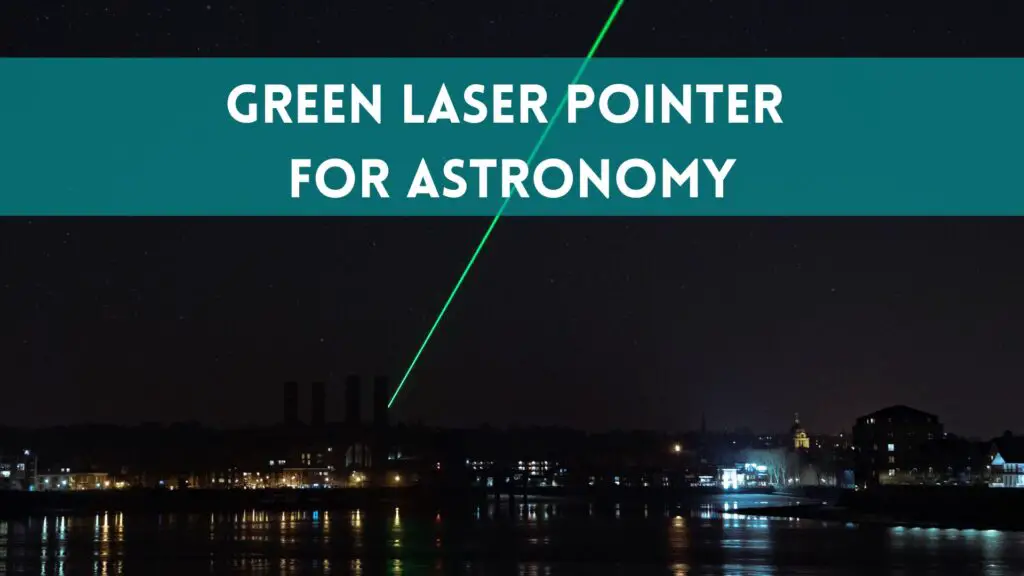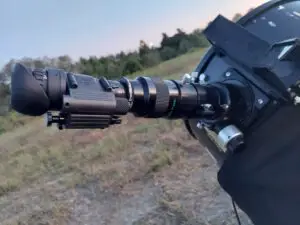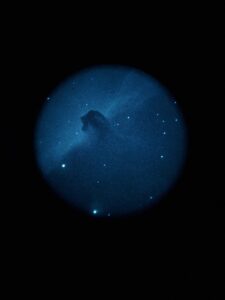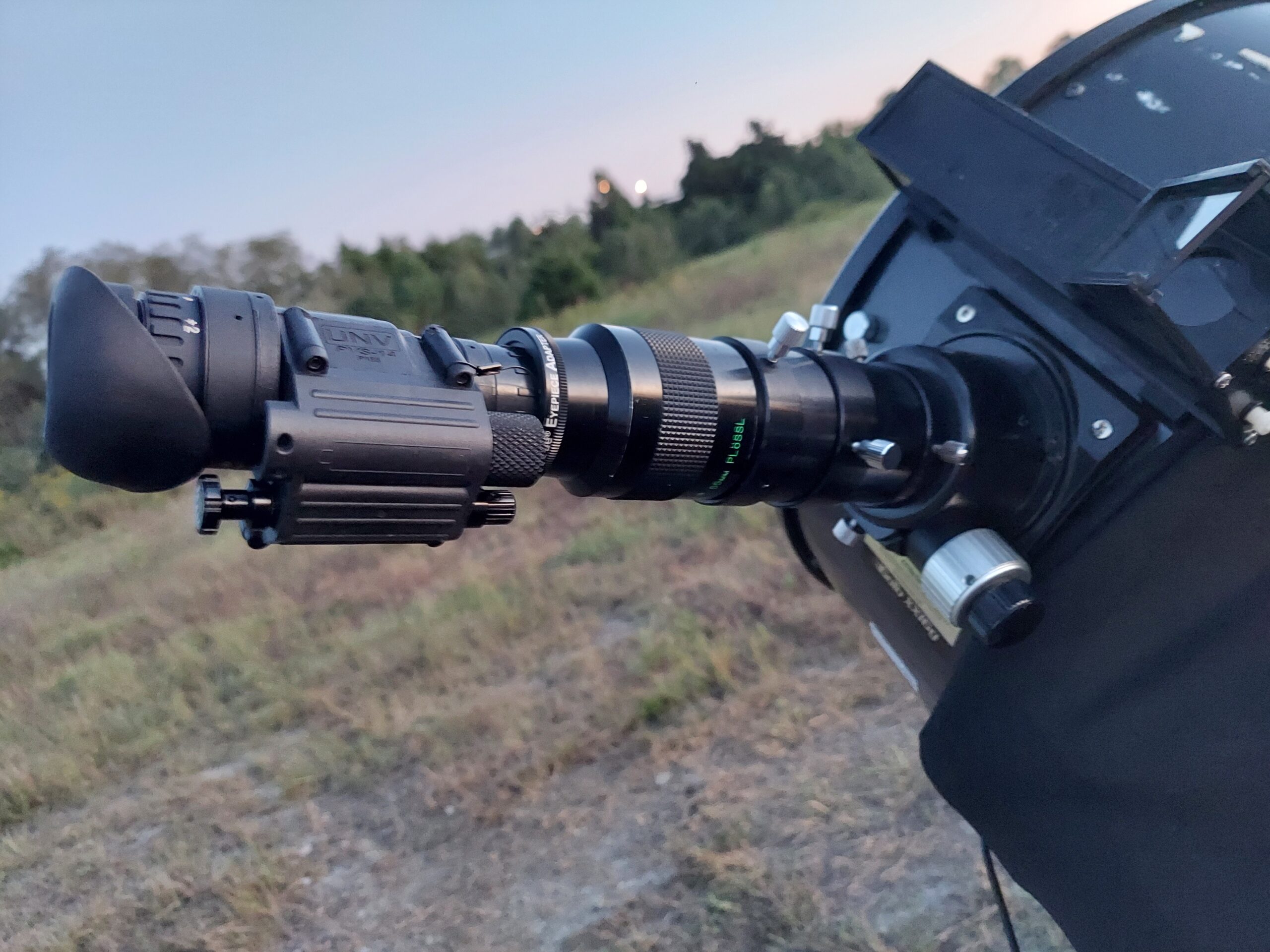A green laser pointer can be a useful tool for astronomy. However, they can also be annoying, dangerous, and even illegal in some jurisdictions.
In this article, we’ll look at the common uses for laser pointers in astronomy and the potential risks of using one.
Why Use a Green Laser Pointer?
The main use for a green laser pointer, unsurprisingly, is to point at things.
In astronomy we use green lasers over other colors mainly because the human eye is more sensitive to green light than to the more common red laser light. This means we can detect green laser beams more easily and to a greater distance. This also makes them more efficient.
There are two main uses for laser pointers:
Laser finder
Some like to use green laser pointers as a replacement for a “zero power” device like a Telrad or red dot finder.
They serve the same purpose—to show where your telescope is pointed—but have the advantage of not requiring you to look through them.
Instead, you can just look to the sky to see where your telescope is pointed. This can be beneficial for someone observing with back pain, for instance, as it frees you from having to bend over and crane your neck to peer through a more traditional finder.
To mount a laser pointer on your telescope, you will need a specialized bracket to hold it, this specialized one from Orion can hold a finderscope and a green laser pointer. These brackets typically fit into a standard Synta-style finder shoe.
Education/Outreach
The other use for laser pointers is not to help you, but to help others.
If you’ve ever tried to point to a certain part of the sky with just your finger, you probably know it is not easy.
“No, not that star, that one! To the left!” A green laser pointer is a fast, effective way to direct someone’s gaze to an exact point in the sky.
On a dark, clear night, the laser beam seems to reach all the way to the stars themselves; an impressive sight! They can also be used to trace constellation outlines and other star patterns.

Risks of Using a Laser Pointer
More so than any other piece of astronomy gear, there is a potential for misuse of green laser pointers. Here are the main risks associated with laser pointers.
Eye damage
Laser beams are harmful to human eyes.
This is particularly true for high-powered devices, where damage can literally occur faster than you can blink. It doesn’t need to be a direct beam, either; laser beams readily bounce off mirrors and other reflective surfaces.
Illegal usage
There can be serious legal consequences for the misuse of a laser pointer. NEVER point a laser beam at any sort of vehicle or aircraft!
In the USA, such behavior is a federal offense and carries a prison term and large fine. Children in particular want to aim the beam at any moving lights in the sky.
There may be restrictions on the usage of laser pointers where you live.
The USA has a 5mW limit on green laser pointers; other countries have already banned them outright. Before purchasing one, check with local authorities to ensure the device is legal to own and operate where you live.
Nuisance usage
As cool as green lasers are, they can be annoying for those outside of the observing party. This is especially true at dark sky sites where Astrophotographers might be shooting long-exposure images.
Here are some guidelines for safe usage of green laser pointers.
- Always check for aircraft before deploying a laser pointer.
- Keep away from children and never leave them unsupervised with a laser pointer.
- Avoid sweeping the sky with the beam. Aim the pointer first, then deploy the beam briefly.
- Never point the beam at an unknown star, as it might be a plane. Depending on their direction of travel, aircraft may not show much apparent motion in the sky. If you are unsure of what you are pointing to, circle the star instead of targeting it directly.
- Use a low-powered device. 5mW is sufficient.
- Be aware of your surroundings. Be mindful of sites where Astrophotographers may be imaging.
- Never point a laser beam at any vehicle or living creature.
Tips for Buying a Green Laser Pointer
The National Institute of Standards and Technology (NIST) published a report on their website in which they randomly tested over a hundred commercially-available laser pointers in the US.
They discovered that an alarmingly high percentage of these devices were out of compliance with federal safety regulations; namely, they produced power levels exceeding the legal limit for Class 3R devices, in some cases by over ten times.
This should be of concern to potential users since the risk of harm increases as power increases.
Without a means of testing the power output yourself, it is impossible to determine the accuracy of any power ratings on a laser pointer.
Your best bet is to buy from a reputable dealer who will stand behind the quality of the product, rather than just buying the cheapest one online.
Here are some options:
Orion SkyLine Deluxe Green Line Laser Pointer
Z-Bolt Green Laser Pointer (Designed for use in lower temperatures)
Adhere to the regulations in your country when buying a laser pointer. There is no real advantage in going over 5mW; it will only drain batteries faster and introduce needless safety hazards.
For added safety, avoid devices which can stay on after releasing the power button.
Can a Laser Collimator Be Used as a Pointer?
Laser collimators are entirely different devices from laser pointers.
They typically use red lasers and operate at much shorter range than laser pointers, meaning they are less powerful by design. The beam will not be as visible as a green laser pointer, so it is unlikely your laser collimator will make an effective pointer.
The reverse is also true; a laser pointer would not be suitable as a collimator, as it lacks the design features necessary for accurate alignment of your mirrors.











